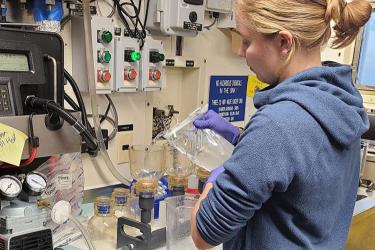NMFS issues a final rule to revise regulations requiring seabird avoidance measures in the hook-and-line groundfish fisheries of the Bering Sea and Aleutian Islands management area (BSAI) and Gulf of Alaska (GOA) and in the Pacific halibut fishery in U.S. Convention waters off Alaska. This action is intended to improve the current requirements and further mitigate interactions with the short-tailed albatross (Phoebastria albatrus), an endangered species protected under the Endangered Species Act (ESA), and with other seabird species in hook-and-line fisheries in and off Alaska, according to James W. Balsiger, Administrator, Alaska Region, National Marine Fisheries Service (NMFS). The North Pacific Fishery Management Council took final action on these measures in December 2001 and a proposed rule was published on February 7, 2003 (68 FR 6386).
Who Must Use the New Seabird Avoidance Measures?
Seabird avoidance measures will apply to the operators of vessels using hook-and-line gear for:
- Pacific halibut in the Individual Fishing Quota (IFQ) and Community Development Quota (CDQ) management programs (0 to 200 nautical miles (nm)),
- IFQ sablefish in EEZ waters (3 to 200 nm) and waters of the State of Alaska (0 to 3 nm), except waters of Prince William Sound and areas in which sablefish fishing is managed under a State of Alaska limited entry program (Clarence Strait, Chatham Strait), and
- groundfish (except IFQ sablefish) with hook-and-line gear in the U.S. EEZ waters off Alaska (3 to 200 nm).
- Other than noted above, vessel operators using hook-and-line gear and fishing for groundfish in waters of the State of Alaska must refer to seabird avoidance measures in State regulations.
- Exemption: Operators of vessels 32 ft (9.8 m) LOA or less using hook-and-line gear in IPHC Area 4E in waters shoreward of the EEZ are exempt from seabird avoidance regulations.
What are the New Seabird Avoidance Requirements?
The primary requirements are:
- Seabird avoidance gear must be onboard, made available for inspection upon request by specified persons, and must be used while hook-and-line gear is being deployed.
- Use of a line or lines designed to deter seabirds from taking baited hooks (paired streamer line, single streamer line, or buoy bag line).
- Offal discharge methods, including removal of hooks from any offal that is discharged.
- Seabird Avoidance Plan?a new reporting requirement. Must be written, current, and onboard the vessel. This new Seabird Avoidance Plan is available on the Seabird Bycatch website.
What Type of `Bird Scaring Line' Must be Used?
The type of `bird scaring line' you are required to use depends on the area you fish, the length of your vessel, the superstructure of your vessel, and the type of hook-and-line gear you use (e.g. snap gear). See the actual regulations for your specific requirements.
- Larger vessels [greater than 55 ft (16.8 m) length overall (LOA)] in the EEZ must use paired streamer lines of a specified performance and material standard.
- Smaller vessels [greater than 26 ft (7.9 m) LOA and less than or equal to 55 ft LOA] must use a single streamer line or, in limited instances, a buoy bag line. Required performance and material standards are not specified for smaller vessels.
- In certain situations, an additional device must be used, adding weights to the groundline, use of a second buoy bag line or streamer line, or strategic offal discharge to distract birds away from the setting of baited hooks.
Is `Night-Setting' an Option as a Seabird Avoidance Measure?
No. Night-setting, the use of a line shooter, or the use of a lining tube (for underwater setting of gear) must be accompanied by the applicable seabird avoidance gear requirements as specified in regulation.
Are Free Streamer Lines Still Available?
Yes. See the seabird bycatch website for the nearest Streamer Line distribution center.
What Do I Do if I Accidentally Hook Birds While Hauling Gear and They Come Onboard Alive?
The new regulations continue to require that every reasonable effort be made to ensure that birds brought on board alive are released alive. The U.S. Fish & Wildlife Service (USFWS) says that these live birds should be released on site if they meet ALL of the following criteria:
- Bird can stand and walk using both feet.
- Bird can flap both wings and there is no apparent wing droop.
- Bird is alert, active, holds its head up and reacts to stimuli.
- Bird is not bleeding freely.
- Wing and tail feathers have not been lost and are in good condition.
- Bird is waterproof (water beads up on feathers).
If the bird does not meet all of these criteria, then see Appendix 2 of the USFWS Biological Opinion on the Effects of the Total Allowable Catch-Setting Process for the Gulf of Alaska and Bering Sea/Aleutian Islands Groundfish Fisheries to the Endangered Short-tailed Albatross (Phoebastria albatrus) and threatened Steller’s Eider (Polysticta stelleri), September 2003 for details on how to care for the bird.
When Are the New Regulations Effective?
The new regulations are effective February 12, 2004, 30 days after the publication of the final regulations in the Federal Register (69 FR 1930, January 13, 2004).
This action is necessary to improve the effectiveness of seabird avoidance measures and further reduce the incidental take of seabirds in the hook-and-line fisheries off Alaska. The action is issued pursuant to 50 CFR Part 679.
This information bulletin only provides notice of a regulatory change. For the purposes of complying with the regulatory change, you are advised to see the actual text of the regulation in the Code of Federal Regulations. Additional information can be found at the NMFS Alaska Region website “Seabird Bycatch Information for Alaska Fishermen” or by contacting Kim Rivera, NMFS’s Seabird Coordinator, 907-586-7424.


